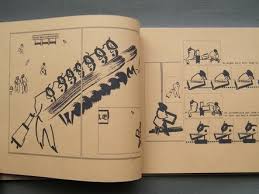Bodea's formal choices were interesting. The figures were painted with swift, squiggly brush strokes, providing just enough structure to understand figure, foreground, background and other key items. The text (which almost looks typeset) is circled on just one or two highlighted letters and then is pointed to a panel. With this simple set of tools, Bodea uses a landscape formatting to craft a number of panels about people waiting in line, the kind of food they eat, and what clean-up is like. Most of the refugees don't speak the same language as the coordinator, making some conversations difficult. The volunteer/author is able to help with the situation of one refugee's family, which he thought was being persecuted for having children by a childless couple. The careful smudges and brushstrokes quickly become an elegant kind of shorthand language that's both word and picture in its own way. The images are small and Bodea's strategy is to whip the eye across the page quickly, especially when depicting motion.
It is the details that allow Bodea to tell a bigger story. The refugees are in Germany and hoping for a better life. They have nowhere else to go. They are depending on the kindness of the centers, eager to eat the food in front of them and comfortable enough to complain when something's missing but also paranoid as to whether as to if the sugar is poisoned. Bodea helps someone who speaks the same language as him get to a train station, where they encounter a desperate man who has lost his papers on the underground. You may as well lose your soul or your memory in a situation like this. Bodea's ability to communicate so much with a simple brushstroke speaks to the power of that image as well as finding a way to create a rhythm with it. There are small joys and small heartbreaks, often revolving around children. There is bureaucratic weirdness (the volunteers have to handle certain items, usually for liability reasons), but there's also a genuine sense of caring. In the back of the book, added as inserts, are a couple of cards that detail certain items (the book is heavily object-oriented, meaning different foods and their containers most often) and how they made Bodea feel, as well as another card that has a "list" of characters and where they were from. Above all else, the book reveals the daily life of the dispossessed (and it is hinted that many of them are Muslim), those hoping for a new and better life, and those who haven't quite reached it yet but are being materially aided and not abjected by the people in their potential new homes.






No comments:
Post a Comment